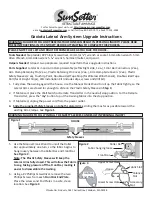
5
Adjust the pitch of your Awning
Tools Needed: 6mm Allen wrench (included with Awning), large adjustable wrench, step ladder(s), and a helper(s).
Note
: A Visual Guide is available on the Installation DVD and on the Owner’s Corner.
43. Close the Awning.
44. Have your helper slightly lift the Front Bar close to the Front Bar Connector, to remove pressure on the Arm Clamp.
45. Remove the plastic cover from the Arm Clamp. Remove by hand, no tools required. See
Figure 19 on Page 6.
46. Using an adjustable wrench,
tighten the large Lock Nut in the Arm Clamp
for safety. See
Figure 20 on Page 6.
47. Release the Front Bar and stand to the side of the Awning.
48. Open the Awning.
49.
Loosen the large Lock Nut in the Arm Clamp, not more than one quarter turn
. See
Figure 20 on Page 6.
Note
: Adjust each Lateral Arm, one at a time, until both are at the desired height and the Front Bar is level.
Note
: Depending on the Awning size and model, the weight of the Front Bar varies (Example: Wider Awnings will have
heavier Front Bars). This will impact how high you can raise the Front Bar, using the adjustment capabilities of the Arm
Clamps. See Figure 20 on Page 6 for the Pitch Channel Range. If you reach the maximum adjustment and are still not
happy with the height of the Front Bar, you can shim the Wall Brackets upward to raise the Front Bar further. Make sure
that all Wall Brackets are shimmed evenly.
To raise the Front Bar, complete steps 50 - 54:
WARNING: RAISING THE FRONT BAR WILL REDUCE THE PITCH (ANGLE) OF THE FABRIC THUS INCREASING THE RISK
OF RAINWATER POOLING ON THE FABRIC. TO PREVENT THE AWNING FROM COLLAPSING DUE TO RAINWATER LOAD,
YOU MUST RETRACT THE AWNING WHEN UNATTENDED. FAILURE TO DO SO COULD RESULT IN PERSONAL INJURY.
To lower the Front Bar, complete steps 55 - 60:
55. Slightly lift the Front Bar (close to the Front Bar Connector) to remove pressure on the Arm Clamp.
56. Loosen
Set Screw #2
until the Front Bar can be lowered to reach the desired height. See
Figure 20 on Page 6
to see
the Channel in the Arm Clamp showing high and low range of pitch.
57. Release the Front Bar.
58. Tighten
Set Screw #1
.
59. Check height. Adjust as necessary, then go to
Step 60.
50. Slightly lift the Front Bar (close to the Front Bar Connector) to remove pressure on the Arm Clamp.
51. Loosen
Set Screw #1
while lifting Front Bar, until the Front Bar is above the desired height. See
Figure 20 on Page 6
to
see the Channel in the Arm Clamp showing high and low range of pitch.
52. While holding the Front Bar above the desired height, tighten
Set Screw #2
.
Note
: Setting the Front Bar above the desired height allows room for settling when you release the Front Bar.
53. Release the Front Bar and tighten
Set Screw #1
.
54. Check height. Adjust as necessary, then go to
Step 60.
60. The Front Bar should be level. If not, adjust the height of either Arm, according to the steps, above.
61. Slightly lift the Front Bar (close to the Front Bar Connector) to remove pressure on the Arm Clamp.
62.
Tighten the large Lock Nut in the Arm Clamps.
See
Figure 20 on Page 6.
63. Release the Front Bar and check for level. If tilted, adjust the height of either Arm, according to the steps above.
64. Push the Front Bar down. If it moves from the desired height, repeat the steps above.
65. Replace the Plastic Cover to the Arm Clamp. Align the plastic guides, press by hand. See
Figure 19 on Page 6.
66. Note
: Depending on adjustments, the Open/Close position stops may need to be adjusted to correct any sagging
that may occur to the Fabric. Follow the procedures in the Awning Owner’s Manual to change these settings.










